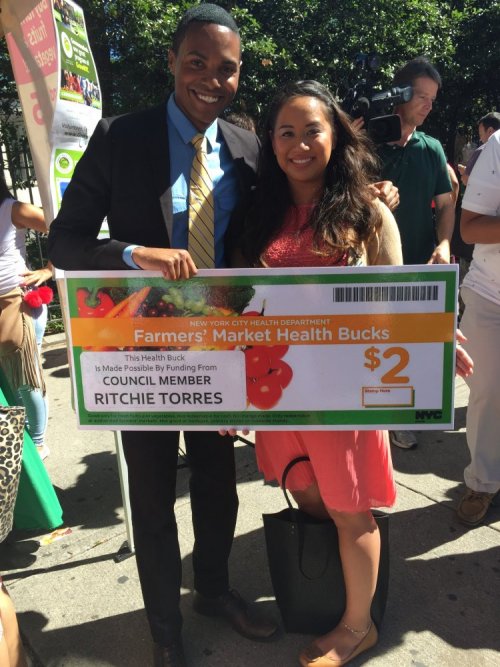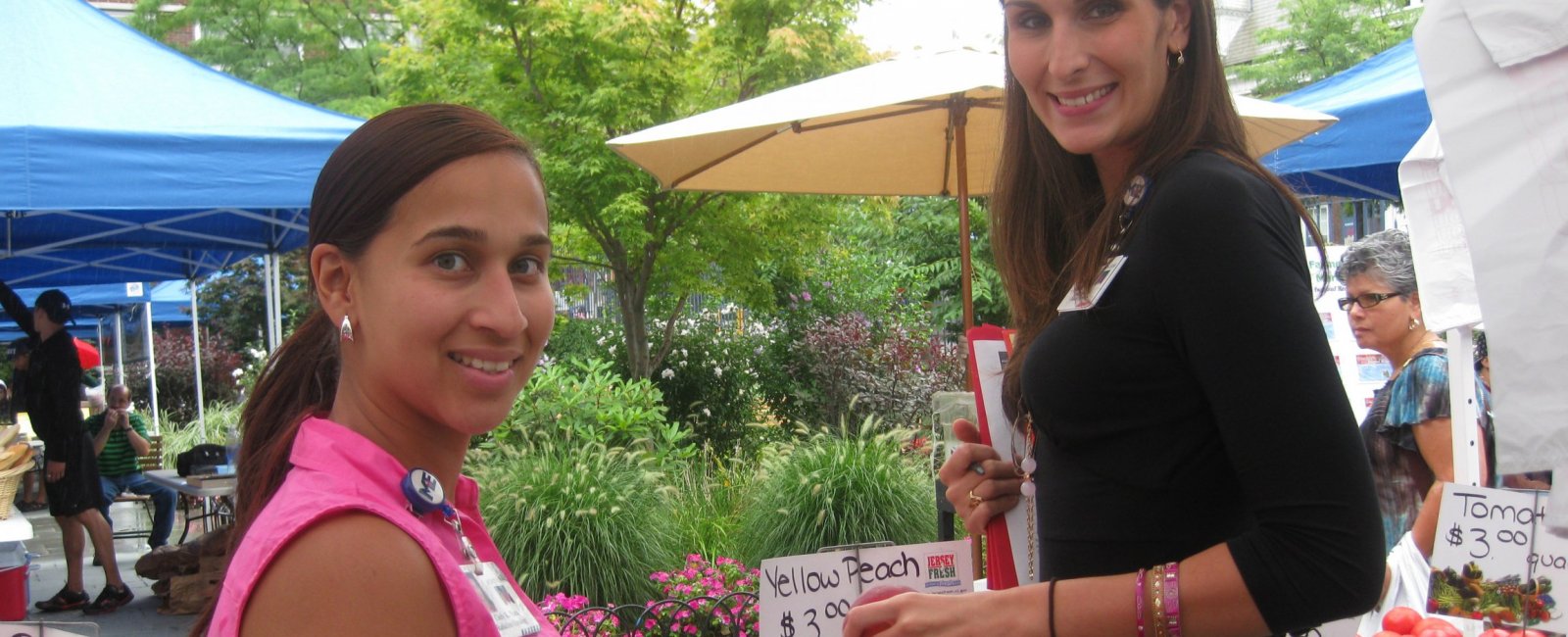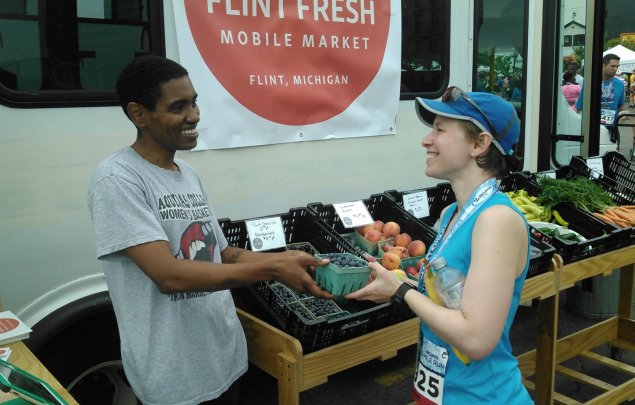Making the healthy choice the easy choice
Takeaways
- Bronx County, New York has an extremely diverse and health-challenged population. For several years running, the Bronx has ranked last among New York State counties in the County Health Rankings and Roadmaps.
- Montefiore Medical Center has a long-standing history of working with community and governmental partners to address pressing community health needs.
- As part of its community benefit investment strategy, Montefiore’s office of community and population health carries out key programs focused on increasing access to healthy food:
- Montefiore participates in Health Bucks, a fruit and vegetable voucher program run by New York City. Montefiore has a 98 percent redemption rate for the Health Bucks that they distribute.
- The Montefiore Healthy Store Initiative helps bodegas in targeted neighborhoods prioritize healthy food options through investment, support, and education.
- Hospital Name: Montefiore Medical Center
- Hospital Type: Private, nonprofit, major teaching hospital
- Hospital Size: Large (1,536 beds)
- Geographic area: Urban
- System/Network: Montefiore Health System
- Network coverage: Bronx County, Westchester County, and parts of Orange and Rockland counties in New York State
- Hispanic/Latino (any race): 55.1%
- Non-Hispanic Black: 29.3%
- Non-Hispanic White: 10.0%
- Community Health Needs Assessment region: Bronx County
- Population: 1.46 million
- Poverty: 27.9% of families, 43% of children
- Obesity: 30.3% of adults, 13.4% of children
- Diabetes: 14% of adults
Montefiore Medical Center, located in the Bronx — the northernmost borough of New York City — serves a culturally rich and diverse community. With nearly 1.5 million people in 42 square miles, the Bronx is the third most densely populated county in the United States. Within this small area, many distinct neighborhoods exist. The Bronx has both one of the poorest congressional districts in the country and affluent neighborhoods. Thirty-five percent of Bronx residents were born in other countries, and the county’s population includes “numerous groups with low-health-literacy, limited income, English proficiency, insurance or insurance knowledge.”
For eight years running, the Bronx has ranked last (62 out of 62) among the counties of New York State in the County Health Rankings and Roadmaps. Mortality rates for diabetes, heart disease, and stroke in the Bronx exceed both New York City and national levels, as do adult and child obesity rates. While data show improvements across the county and New York City as a whole, the prevalence of diabetes and obesity in the Bronx still exceed citywide rates (for diabetes 14 percent as compared to 10.7 percent citywide and for obesity 30.3 percent as compared to 24.7 percent). Along with high rates of diet-related disease and obesity, nearly one in five Bronx residents struggle with hunger.
Community health needs assessment: Priorities and process
- Food and diet-related disease priorities:
- 2013 CHNA: Prevention of diet-sensitive chronic disease and reducing obesity in children and adults
- 2016 CHNA: Obesity and diet-related conditions including diabetes, hypertension, asthma and cardiovascular disease
- Participation from food-based organizations in community health needs assessment (CHNA) process:
- Food Bank for New York City as well as representatives from local food pantries, community supported agriculture organizations, and farmers market associations
- How/why did obesity emerge as a priority?
- Secondary data analysis and information gathered at community meetings consistently pointed to obesity and related health issues as primary community health concerns.
- Key community indicators:
- 35.8% of households receive Supplemental Nutrition Assistance Program (SNAP) benefits.
- 30.3% of adult residents in the Bronx are obese as are 13.4% of children
Full Assessment: Montefiore Medical Center Community Health Needs Assessment and Implementation Plan 2016-2018
Assessing health needs — and how to meet them
Community health needs assessment process
Montefiore’s community health focus is an integral and long-standing part of its work. The medical center is a major teaching hospital, affiliated with Albert Einstein College of Medicine, and is connected to an extensive network of primary and specialty care centers located across the Bronx. Its school-based health program is the largest public school primary and preventive care program in the United States. Montefiore is also the largest employer in the Bronx, a position which further drives its community commitment.
Over the last three decades, Montefiore has built strong relationships with a host of community and governmental partners working on community health initiatives. These partnerships reflect a concerted effort to address the persistent health challenges faced by Bronx residents, from the AIDS epidemic to obesity and chronic disease. The hospital’s office of community and population health frequently works with New York City Department of Health and Mental Hygiene and its district public health office both on health program initiatives and data collection efforts, for and outside of the community health needs assessment (CHNA) process. Montefiore also works with numerous community-based organizations and participates in coalitions, including #Not 62 Coalition — The Campaign for a Healthy Bronx.
Montefiore’s CHNA is a product of collaboration with its partners. For the 2016 assessment, the department led a series of “Community Consultations” to collect primary data, through community-based meetings, that it then shared with hospitals for their reports. Eight such events were held in the Bronx. Montefiore also engaged with its facilities’ community advisory boards to identify health needs and appropriate service delivery for specific communities. The priority focus on obesity to address chronic disease resulted from both the data review and the feedback received via community conversations as well as the alignment with state and local priority areas, set forth in the New York State Prevention Agenda and Take Care NYC 2020, New York City’s health improvement plan.
Investing in solutions
Implementation strategy
Montefiore’s chosen interventions align with the New York State Prevention Agenda and complement broader, coordinated efforts at work in the community to improve health and to address health disparities. The chosen intervention strategies focus on the specific populations with the most significant health concerns. The hospital invests significant staff time and resources in healthy food access initiatives and in food and nutrition education activities.
— Amanda Parsons, Montefiore Health System vice president of community and population health
Health Bucks
This fruit and vegetable incentive program provides vouchers for fresh produce to patients who participate in Montefiore’s health education program and diabetes prevention classes and in guided farmers market walks.
- Program type: Fruit and vegetable voucher program
- Program administrator: New York City Department of Health and Mental Hygiene
- Program founded: 2001
- Hospital role: Participate in a community collaboration; conduct nutrition, food, and cooking education
- Community partners: New York City Department of Health and Mental Hygiene, New York City Department of Parks and Recreation, Harvest Home Farmers Market
- Population served: Patients who participate in Montefiore’s health education program and diabetes prevention classes and individuals who take part in market tours
- Program goal: To increase access to fruits and vegetables, expand access to farmers markets, physical activity (going for a walk).
- Health needs addressed: Healthy eating and diabetes
- Key outcomes: Montefiore has a 98 percent redemption rate for the Health Bucks that they distribute. Staff members lead walks to and through ten farmers markets across the Bronx borough.
Project description
Health Bucks, a program of the New York City Department of Health, makes fresh fruits and vegetables more affordable and accessible. Montefiore is one of a multitude of organizations working across New York City to distribute Health Bucks. Distributors receive the $2 coupons, redeemable at farmers markets, to be given out as part of a Supplemental Nutrition Assistance Program (SNAP incentive program or to participants of nutrition education classes. Introducing individuals to Health Bucks can be particularly valuable for SNAP recipients, who can receive additional Health Bucks (one $2 voucher) for every $5 spent using SNAP benefits.
Program participation
Montefiore distributes Health Bucks to individuals who participate in specific health education classes and those who take part in farmers market tours. Healthy eating classes generally target patients with pre-existing conditions. The farmers market tours serve the broader community, and anyone who attends is eligible to receive a Health Bucks voucher on that day.
“The biggest thing to keep in mind is to reach beyond your own hospital. If you see something that is good for your patients, it is going to be good for the community. We have a responsibility across the county. If people are eating more fruits and vegetables, the community will be healthier by default.”
— Nicole Hollingsworth, Montefiore Health System assistant vice president community and population Health
Partnerships and hospital role
Montefiore is one of numerous organizations collaborating with the Department of Health and Mental Hygiene to implement Health Bucks. Montefiore’s office of community and population health applies to the department to participate in the program, and staff members, namely nutrition and health educators, manage coupon distribution. The department provides a range of support, such as guidance for engagement activities, that Montefiore has adapted for its community and carries out data collection to track redemption rates.
Another partner in Montefiore’s efforts is City Harvest. Starting in 2007-2008, City Harvest began setting up farmers markets as part of a wider effort to increase fruit and vegetable consumption and improve healthy food access. Many of these markets are located in close proximity to Montefiore clinics, making it easy to conduct market tours in conjunction with nutrition education classes.

Farmers market walks
Montefiore nutritionists and health educators lead regular farmers market walks from June to November at ten markets located near Montefiore clinics. These walks have emerged as an ideal way to expose individuals to the availability of fresh produce in the community. Staff members share information on seasonal produce, shopping and storage, and discuss recipes and preparation encouraging participants to try new vegetables. With the availability of Health Bucks, individuals have the leeway to try new items, without concern for cost. “We need to get people trying and eating vegetables, without feeling like they will use their entire SNAP allocation by eating healthy,” attests Dr. Amanda Parsons, Montefiore Health System vice president of community and population health. While patients and class participants are the target audience, walks are open to anyone and community members often jump in to take part.
Financing
Montefiore obtains the Health Bucks, at no charge, from the Department of Health and Mental Hygiene. Hospital staff time, both for education activities and for implementation and administration, is dedicated to carrying out the program as part of Montefiore’s community benefit strategy. The hospital also secures grants to support activities and projects that aim to increase engagement in healthy eating and leverages the availability of Health Bucks to advance those efforts.
Program evaluation and impacts
Program evaluation is carried out by both Montefiore and the New York Department of Health and Mental Hygiene. Montefiore staff members monitor and track coupon distribution, and the hospital submits distribution data to the department. The department also tracks redemption rates based on distribution data, by scanning the barcode on each coupon. Montefiore has a 98 percent redemption rate for its vouchers and is the largest distributor of Health Bucks in New York City.
Internally, Montefiore administers a survey to participating patients to assess the quality of education classes and tours. Participants overwhelmingly reported that the activities offer valuable information about how to shop for and eat healthy foods.
Lessons learned
Health Bucks is one of multiple programs administered through Montefiore’s Office of Community and Population Health. The involvement of the New York Department of Health and Mental Hygiene as a central entity that can efficiently track redemption rates of coupons is critical to assessing program impact.
Montefiore healthy store program
This healthy corner store program targets Bronx communities with the highest rates of obesity.
- Program type: Healthy retail store program
- Program administrator: Montefiore’s office of community and population health
- Program founded: 2013
- Hospital role: Manage or coordinate a program; conduct food, nutrition, and cooking education
- Community partners: New York Department of Health and Mental Hygiene, bodega owners, Bronx Bodega Work Group, Jetro, various community-based organizations
- Population served: Primarily the Bronx neighborhoods of Highbridge, Morrisania, Eastchester, and Fordham Kingsbridge
- Program goal: To increase the number of key retailers stocking healthy food and beverage items.
- Health needs addressed: Obesity
- Key outcomes: Montefiore has helped nine bodegas earn the Shop Healthy NYC! designation. Its work with Jetro, the main wholesaler for greater metropolitan New York bodegas, to promote healthy products to store owners greatly increases the reach of its efforts.
Program description
Since 2011, Montefiore has conducted a healthy store program. Montefiore works with local retail stores, called bodegas, to increase their inventory of fruits and vegetables, whole grain items, low-sodium foods, and low-added sugar foods and beverages, as well as to increase the visibility of water, and to develop healthy menu combinations for people who are coming in for take-out meals.
Montefiore aims to meet store owners where they are, recognizing that flexibility and creative approaches will help them get more healthy food on store shelves. While bodegas are encouraged to hit specific targets in order to be designated as a Shop Healthy NYC! store, Montefiore works with some store partners in a more incremental process. Montefiore gives participating stores a variety of resources to promote healthy items, including door signage and shelf labels and decals. Stores that receive Shop Healthy designation are also recognized with a proclamation from the Bronx borough president.
Montefiore staff members conduct substantial outreach to store owners to introduce the program, to learn about the businesses, and to identify opportunities to influence change. Staff members recognize that changes need to be feasible (profitable or at least cost neutral) for bodega owners. As part of its store engagement effort, Montefiore gives stores a sample of healthy foods ($50 value). This food kit includes items such as low-sodium beans, high-fiber cereal, fruit, and snack bars. All items are marketable, giving store owners a chance to test out stocking items at no cost. If the samples sell, Montefiore asks stores to stock the healthy items. On occasion, Montefiore also co-hosts events with bodegas to introduce new nutritious foods to customers. These events have included smoothie stands and tastings with chefs and nutritionists.
Staff members regularly visit participating stores to provide technical assistance, specifically around signage, display, and promotion. For instance, if Montefiore staff members visit a store that has produce items in boxes on the floor or in a corner, they offer free baskets and give guidance on how to display the produce in a way that makes it more visible and attractive to customers. Montefiore distributes labels, decals, and signs for stores to use to promote healthy items.
To make it easier for bodega owners to identify healthy items for their stores, Montefiore works with Jetro, a retail supplier for 98 percent of the bodegas in the Bronx. Jetro allows Montefiore to label healthy items throughout its warehouse, and also provides space for a large resource rack, right next to the entrance, that offers bodega owners pricing signs for fruits and vegetables and tips and tricks on how to stock and store healthier food items, and ways to contact Montefiore program staff members for additional information.
The specific targets of Shop Healthy NYC!
If store owners achieve these seven specific targets, they can receive the "Shop Healthy" designation:
- Stock low-sodium canned goods and canned fruit in 100 percent juice.
- Stock at least two healthy snacks (fewer than 200 calories).
- If the store has a deli counter, offer and promote a healthy sandwich or meal combination (with a piece of fruit and water).
- Offer fruits and vegetables at the front of the store or at checkout. For supermarkets, create and maintain a healthy checkout aisle that stocks only healthy foods and drinks or nonfood items like magazines or household items. In supermarkets, improve the produce section.
- Display water and low-calorie drinks at eye level.
- Promote healthy foods and beverages using signage on shelves and refrigerators, including shelf inserts, refrigerator decals, door signs, stickers, magnets, price signs and posters.
- Remove advertising from the entry door.
Program participation
Montefiore’s corner store efforts are zip code specific. To target the communities most in need of increased access to fruits and vegetables, Montefiore used patient data to identify neighborhood blocks where 300 or more patients with obesity resided, then researched these blocks to see whether or not they had bodegas, and selected areas with both high-obesity patient density and high-bodega density. The program currently operates in stores in the Highbridge, Morrisania, Eastchester, and Fordham-Kingsbridge neighborhoods.
Partnerships and hospital role
Montefiore administers its healthy store program through its office of community and population health. In helping stores meet Shop Healthy criteria, Montefiore is supporting the citywide initiative run by the Department of Health and Mental Hygiene and the New York City Center for Economic Opportunity. These partners offer guidance to support program development Montefiore has adapted for use in its efforts.
Jetro, the wholesaler, is an integral partner in Montefiore’s work. Through its partnership with Jetro, Montefiore is able to educate bodega owners on which items are healthy and also to increase the visibility of those healthy items to owners when they are planning and shopping for inventory. Jetro’s position as the main retail supplier for bodegas means Montefiore’s reach extends to many stores beyond the neighborhoods targeted directly by its program.
Financing
Montefiore’s office of community and population health provides staff time and resources to carry out the healthy store activities. Within the office, there is a team of four staff members that work on these efforts as part of a larger portfolio of healthy eating programs. Montefiore funds the production of all the materials (posters, labels, and decals) distributed to stores and used at the Jetro warehouse. The hospital periodically seeks grant funding to support program activities and program expansion. For instance, a CDC grant to the Bronx REACH CHAMPS program, in which Montefiore is a partner, enabled the hospital to aid additional stores.
Program evaluation and impacts
Montefiore uses process and outcome measures to evaluate its healthy store efforts. Specifically, staff members track the number of bodegas working with Montefiore, their level of engagement, and the number that have earned Shop Healthy designation. Of the 23 bodegas that Montefiore has targeted, 14 are actively engaged, and nine have received the Shop Healthy designation.
Montefiore also conducts regular visual observations of the stores to see what is being stocked, the quality of the fresh fruits and vegetables, and how it is being displayed and promoted. Staff members have started using an assessment tool to collect data on store inventory and display of healthy items. Montefiore also conducts a survey of store owners to assess where they source inventory from, owners’ knowledge of healthy food, and perceived barriers to stocking more healthy items. Ultimately Montefiore hopes to be able to understand how healthy food availability has changed in targeted areas and whether or not there are changes in the obesity profiles of the patients who live in those areas.
Lessons learned
Engaging stores requires significant time. The bodegas that Montefiore works with are, by and large, small independently-owned businesses. Montefiore staff members have found that it sometimes takes as many as seven times of connecting with a bodega owner before they are willing to explore the possibility of carrying out healthy store activities. One effective strategy Montefiore staff members found was attending Women, Infants, and Children (WIC) vendor training programs, which teach bodega owners how to get set up to accept WIC. When the bodega owners see that Montefiore staff members have a relationship with the WIC vendor training program staff members, they see them as more credible and are more willing to talk with them about the healthy store program. Since WIC already has certain requirements to make their stores healthier, Montefiore’s program can help them achieve these requirements.
Montefiore staff members emphasize the importance of taking the time to learn from other, similar programs. Rather than reinvent the wheel, Montefiore looks to others with experience on similar healthy store projects to learn from them and, in some cases, gain access to relevant materials. They have found that other organizations are always happy to talk and share their “lessons learned.”
“There are plenty of amazing hospitals and partnerships across the globe that have great models and we just need to find out about them and read about them and talk to them and just basically get connected to them.”
— Amanda Parsons, Montefiore Health System vice president of community and population health
When Montefiore Medical Center staff members started working with bodegas in the Bronx, they realized that it didn’t always make business sense for a bodega to hit all of the targets in order to earn Shop Healthy designation For instance, if the bodega was right next to another store that offered fruits and vegetables, then it was not necessary for the bodega to also offer these items, but instead to focus on targets such as stocking low-sodium canned goods, healthier snacks, and displaying water and low-calorie drinks at eye level. This approach enables Montefiore to adapt the program to meet each store’s unique capacity and circumstances while still making progress toward its larger objective of increasing access to healthy food options.
Comprehensive approach
Montefiore’s community-focused efforts complement the hospital’s work, through its food service and clinical care initiatives, to promote nutritious diets and healthy food choices inside its walls. Montefiore clinicians have created a Cardiac Wellness Program centered on a plant-based diet, featuring vegetables, fruits, legumes and beans, nuts, whole grains, and dairy alternatives, and the food service department has incorporated dishes from this program into their patient and cafeteria menus. Patients and retail customers receive handouts on the benefits of plant-based diets. These efforts to promote healthful, plant-based meals are further linked to Montefiore’s greater sustainability initiatives and intention to reduce its environmental impact while promoting patient and community health.









